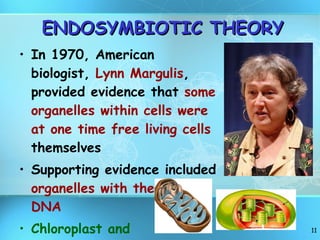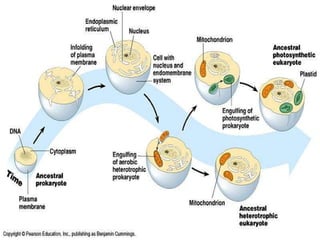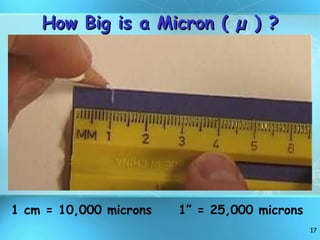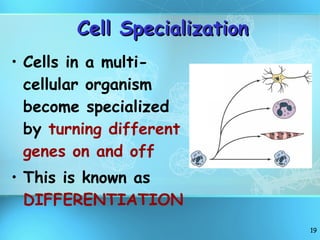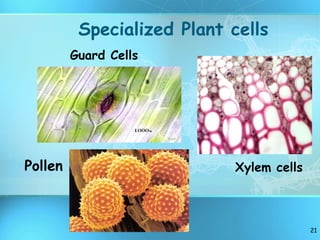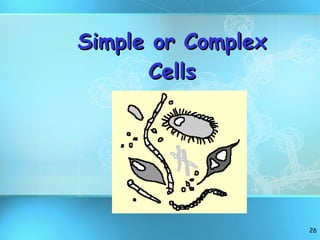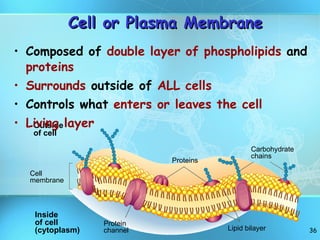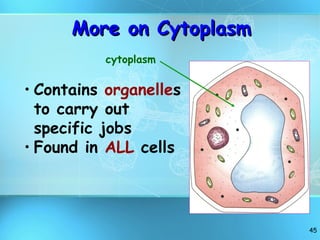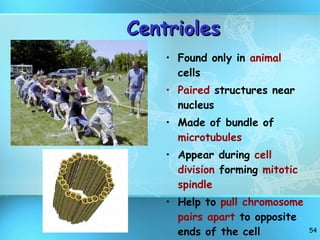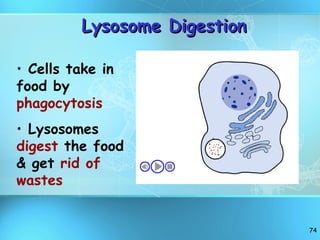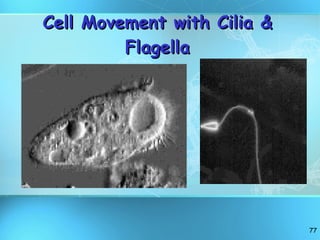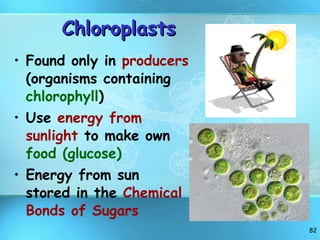Cell structure revised
- 1. Basic Structure of a Cell
- 2. History of Cells & the Cell Theory Virchow Cell Specialization
- 3. First to View Cells In 1665, Robert Hooke used a microscope to examine a thin slice of cork (dead plant cells) What he saw looked like small boxes
- 4. First to View Cells Hooke is responsible for naming cells Hooke called them “CELLS” because they looked like the small rooms that monks lived in called Cells
- 5. Anton van Leeuwenhoek In 1673, Leeuwenhoek (a Dutch microscope maker), was first to view organism (living things) Leeuwenhoek used a simple, handheld microscope to view pond water & scrapings from his teeth
- 6. Beginning of the Cell Theory In 1838, a German botanist named Matthias Schleiden concluded that all plants were made of cells Schleiden is a cofounder of the cell theory
- 7. Beginning of the Cell Theory In 1839, a German zoologist named Theodore Schwann concluded that all animals were made of cells Schwann also cofounded the cell theory
- 8. Beginning of the Cell Theory In 1855, a German medical doctor named Rudolph Virchow observed, under the microscope, cells dividing He reasoned that all cells come from other pre-existing cells by cell division
- 9. CELL THEORY All living things are made of cells Cells are the basic unit of structure and function in an organism (basic unit of life) Cells come from the reproduction of existing cells (cell division)
- 10. Discoveries Since the Cell Theory
- 11. ENDOSYMBIOTIC THEORY In 1970, American biologist, Lynn Margulis , provided evidence that some organelles within cells were at one time free living cells themselves Supporting evidence included organelles with their own DNA Chloroplast and Mitochondria
- 13. Cell Size and Types Cells, the basic units of organisms, can only be observed under microscope Three Basic types of cells include: Animal Cell Plant Cell Bacterial Cell
- 14. Number of Cells Although ALL living things are made of cells, organisms may be: Unicellular – composed of one cell Multicellular - composed of many cells that may organize into tissues, etc.
- 15. CELL SIZE Typical cells range from 5 – 50 micrometers (microns) in diameter
- 16. Which Cell Type is Larger? _________ > _____________ > ___________ Plant cell Animal cell bacteria
- 17. How Big is a Micron ( µ ) ? 1 cm = 10,000 microns 1” = 25,000 microns
- 18. Multicellular Organisms Cells in multicellular organisms often specialize (take on different shapes & functions)
- 19. Cell Specialization Cells in a multi-cellular organism become specialized by turning different genes on and off This is known as DIFFERENTIATION
- 20. Specialized Animal Cells Muscle cells Red blood cells Cheek cells
- 21. Specialized Plant cells Xylem cells Pollen Guard Cells
- 22. Organization Levels of Life Atoms to Organisms
- 23. ATOMS MOLECULES ORGANELLES Nonliving Levels
- 24. CELLS – life starts here TISSUES – Similar cells working together Living Levels
- 25. ORGANS ORGAN SYSTEMS ORGANISM Different tissues working together Different organs working together More Living Levels
- 26. Simple or Complex Cells
- 27. Prokaryotes – The first Cells Cells that lack a nucleus or membrane-bound organelles Includes bacteria Simplest type of cell Single, circular chromosome
- 28. Prokaryotes Nucleoid region (center) contains the DNA Surrounded by cell membrane & cell wall (peptidoglycan) Contain ribosomes (no membrane) in their cytoplasm to make proteins
- 29. Eukaryotes Cells that HAVE a nucleus and membrane-bound organelles Includes protists, fungi, plants, and animals More complex type of cells
- 30. Eukaryotic Cell Contain 3 basic cell structures: Nucleus Cell Membrane Cytoplasm with organelles
- 31. Two Main Types of Eukaryotic Cells Plant Cell Animal Cell
- 32. Organelles
- 33. Organelles Very small (Microscopic) Perform various functions for a cell Found in the cytoplasm May or may not be membrane-bound
- 34. Animal Cell Organelles Nucleolus Nucleus Nuclear envelope Ribosome (attached) Ribosome (free) Cell Membrane Rough endoplasmic reticulum Golgi apparatus Mitochondrion Smooth endoplasmic reticulum Centrioles
- 36. Cell or Plasma Membrane Composed of double layer of phospholipids and proteins Surrounds outside of ALL cells Controls what enters or leaves the cell Living layer Outside of cell Inside of cell (cytoplasm) Cell membrane Proteins Protein channel Lipid bilayer Carbohydrate chains
- 37. Phospholipids Heads contain glycerol & phosphate and are hydrophilic (attract water) Tails are made of fatty acids and are hydrophobic (repel water) Make up a bilayer where tails point inward toward each other Can move laterally to allow small molecules (O 2 , CO 2 , & H 2 O to enter)
- 38. The Cell Membrane is Fluid Molecules in cell membranes are constantly moving and changing
- 39. Cell Membrane Proteins Proteins help move large molecules or aid in cell recognition Peripheral proteins are attached on the surface (inner or outer) Integral proteins are embedded completely through the membrane
- 40. Recognize “self” GLYCOPROTEINS Glycoproteins have carbohydrate tails to act as markers for cell recognition
- 41. Cell Membrane in Plants Lies immediately against the cell wall in plant cells Pushes out against the cell wall to maintain cell shape Cell membrane
- 42. Cell Wall Nonliving layer Found in plants, fungi, & bacteria Made of cellulose in plants Made of peptidoglycan in bacteria Made of chitin in Fungi Cell wall
- 43. Cell Wall Supports and protects cell Found outside of the cell membrane
- 44. Cytoplasm of a Cell Jelly-like substance enclosed by cell membrane Provides a medium for chemical reactions to take place cytoplasm
- 45. More on Cytoplasm Contains organelle s to carry out specific jobs Found in ALL cells cytoplasm
- 46. The Control Organelle - Nucleus Controls the normal activities of the cell Contains the DNA in chromosomes Bounded by a nuclear envelope (membrane) with pores Usually the largest organelle
- 47. More on the Nucleus Each cell has fixed number of chromosomes that carry genes Genes control cell characteristics Nucleus
- 48. Nuclear Envelope Double membrane surrounding nucleus Also called nuclear membrane Contains nuclear pores for materials to enter & leave nucleus Connected to the rough ER Nuclear pores
- 49. Inside the Nucleus - The genetic material (DNA) is found DNA is spread out And appears as CHROMATIN in non-dividing cells DNA is condensed & wrapped around proteins forming as CHROMOSOMES in dividing cells
- 50. What Does DNA do? DNA is the hereditary material of the cell Genes that make up the DNA molecule code for different proteins
- 51. Nucleolus Inside nucleus Cell may have 1 to 3 nucleoli Disappears when cell divides Makes ribosomes that make proteins
- 52. Cytoskeleton Helps cell maintain cell shape Also help move organelles around Made of proteins Microfilaments are threadlike & made of ACTIN Microtubules are tubelike & made of TUBULIN
- 54. Centrioles Found only in animal cells Paired structures near nucleus Made of bundle of microtubules Appear during cell division forming mitotic spindle Help to pull chromosome pairs apart to opposite ends of the cell
- 55. Centrioles & the Mitotic Spindle Made of MICROTUBULES (Tubulin)
- 56. Mitochondrion (plural = mitochondria) “ Powerhouse” of the cell Generate cellular energy (ATP) More active cells like muscle cells have MORE mitochondria Both plants & animal cells have mitochondria Site of CELLULAR RESPIRATION (burning glucose)
- 57. MITOCHONDRIA Surrounded by a DOUBLE membrane Folded inner membrane called CRISTAE (increases surface area for more chemical Reactions) Has its own DNA Interior called MATRIX
- 58. Interesting Fact --- Mitochondria Come from cytoplasm in the EGG cell during fertilization Therefore … You inherit your mitochondria from your mother !
- 59. Cell Powerhouse Rod shape Mitochondrion ( mitochondria )
- 60. What do mitochondria do? Burns glucose to release energy (ATP) Stores energy as ATP “ Power plant” of the cell
- 61. Endoplasmic Reticulum - ER Network of hollow membrane tubules Connects to nuclear envelope & cell membrane Functions in Synthesis of cell products & Transport Two kinds of ER ---ROUGH & SMOOTH
- 62. Rough Endoplasmic Reticulum (Rough ER) Has ribosomes on its surface Makes membrane proteins and proteins for export out of cell
- 63. Rough Endoplasmic Reticulum (Rough ER) Proteins are made by ribosomes on ER surface They are then threaded into the interior of the Rough ER to be modified and transported
- 64. Smooth Endoplasmic Reticulum Smooth ER lacks ribosomes on its surface Is attached to the ends of rough ER Makes cell products that are USED In the cell
- 65. Functions of the Smooth ER Makes membrane lipids (steroids) Regulates calcium (muscle cells) Destroys toxic substances (Liver)
- 66. Endomembrane System Includes nuclear membrane connected to ER connected to cell membrane (transport)
- 67. Ribosomes Made of PROTEINS and rRNA “ Protein factories” for cell Join amino acids to make proteins Process called protein synthesis
- 68. Ribosomes Can be attached to Rough ER OR Be free (unattached) in the cytoplasm
- 69. Golgi Bodies Stacks of flattened sacs Have a shipping side ( cis face ) & a receiving side ( trans face ) Receive proteins made by ER Transport vesicles with modified proteins pinch off the ends Transport vesicle CIS TRANS
- 70. Golgi Bodies Look like a stack of pancakes Modify, sort, & package molecules from ER for storage OR transport out of cell
- 71. Golgi Animation Copyright Pearson Publishers
- 72. Golgi Animation Materials are transported from Rough ER to Golgi to the cell membrane by VESICLES
- 73. Lysosomes Contain digestive enzymes Break down food, bacteria, and worn out cell parts for cells Programmed for cell death (APOPTOSIS) Lyse & release enzymes to break down & recycle cell parts)
- 74. Lysosome Digestion Cells take in food by phagocytosis Lysosomes digest the food & get rid of wastes
- 75. Cilia & Flagella Made of protein tubes called microtubules Microtubules arranged ( 9 + 2 arrangement ) Function in moving cells , in moving fluids , or in small particles across the cell surface
- 76. Cilia & Flagella Cilia are shorter and more numerous on cells Flagella are longer and fewer (usually 1-3) on cells
- 77. Cell Movement with Cilia & Flagella
- 78. Cilia Moving Away Dust Particles from the Lungs
- 79. Vacuoles Fluid filled sacks for storage Small or absent in animal cells Plant cells have a large Central Vacuole No vacuoles in bacterial cells
- 80. Vacuoles In plants, they store Cell Sap Includes storage of sugars, proteins, minerals, lipids, wastes, salts, water, and enzymes
- 81. Contractile Vacuole Found in unicellular protists like paramecia Regulate water intake by pumping out excess (homeostasis) Keeps the cell from lysing (bursting) Contractile vacuole animation
- 82. Chloroplasts Found only in producers (organisms containing chlorophyll ) Use energy from sunlight to make own food (glucose) Energy from sun stored in the Chemical Bonds of Sugars
- 83. Chloroplasts Surrounded by DOUBLE membrane Outer membrane smooth Inner membrane modified into sacs called Thylakoids Thylakoids in stacks called Grana & interconnected Stroma – gel like material surrounding thylakoids
- 84. Chloroplasts Contains its own DNA Contains enzymes & pigments for Photosynthesis Never in animal or bacterial cells










